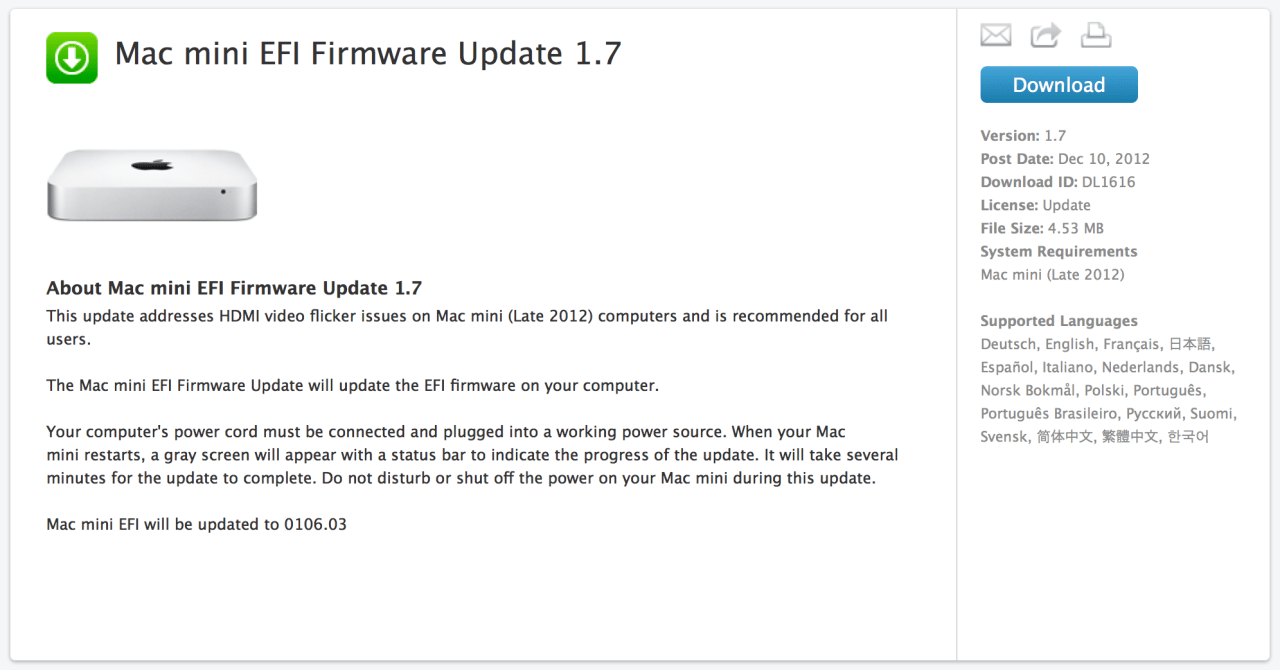

- #Mac pro efi firmware update 1.5 install#
- #Mac pro efi firmware update 1.5 upgrade#
- #Mac pro efi firmware update 1.5 mac#
PS: I carefully checked that my SM951 is a AHCI version.


Your Mac's Specs 15' MacBook Pro 2. When I disconnect the HDD it only boots to the flashing question mark folder. About the iMac EFI Firmware 1.4 Update Fixes the 1.5G SATA Issue. The Startup Manager shows me the SSD, but after choosing it and restart the Mac, it simply boots from the HDD.

#Mac pro efi firmware update 1.5 mac#
(Installation starts, but after the Mac reboots, it does not go ahead, but instead boots from the internal HDD. recent MacBook Pro laptop models, moving from a 3Gbit/sec. I tried it with installing it with the High Sierra installer. Apple said the MacBook Pro EFI Firmware Update 1.7 fixes a problem. I tried it with Carbon Copy Cloner, no success. Under the System Information from the SSD, it says bootable yes, but I can not boot from the SSD.
#Mac pro efi firmware update 1.5 install#
(What I've read this is no problem, I can still install macOS onto it and boot from it). To get a better performance from the HardDrive I want to update to a Samsung SM951 SSD. So, you'll need to erase everything to make sure that the installation package will recognize your SSD as a brand new stick and create a new EFI partition with an APPLE folder with firmware information there.I flashed my Mac Pro from 4.1 to 5.1 Everything works fine. If you don't erase everything the EFI partition where the problem remains will not be deleted and the problem will persists. If you erase everything the old EFI partition will be deleted and the installation package can now write a new EFI partition and you'l get a new Apple folder with a proper firmware from Big Sur. You'll need to boot from the external USB stick and erase all the disk using the option "see all devices", be sure that you'll erase everything, not only a single partition. You'll need to install Mojave from or USB stick to get the "standard" firmware (I'm calling standard because this Mojave firmware enable updates in a NON-Apple SSDs without this firmware warning), when finally Mojave was installed you can update to Monterey and get, again, the latest firmware from macOS 12.1.Įdit: I've read that you are on Big Sur, so, you should already have the latest firmware in your machine, which let me think that there's some problem with your Apple folder in EFI partitioin where the firmware are stored. The problem appears to be hard drive-related, and occurs most frequently with. Mojave firmwrare will allow you to go through Catalina, Big Sur or Monterey if you want. Apple has released MacBook Pro EFI Firmware Update 1.9, which addresses an issue we have covered extensively in which users experience frequent stalls/hangs, accompanied by the spinning beach ball progress indicator, under varying conditions (previously noted here).
#Mac pro efi firmware update 1.5 upgrade#
You'll need to install High Sierra from internet recovery or USB stick or the OS that came out of the box with your mac and get the "standard firmware" (I' calling standard here because it will restore your EFI partition with an genuine APPLE firmware folder), then upgrade to Mojave and get the new firmware which will enable you to update the old firmware and start the counting from Mojave firmware and so on. If your SSD is an APPLE genuine but your firmware is old, it means that probably you're trying to update from High Sierra (or an old OS) to Monterey, because if you've got Mojave you've probably got the firmware update from macOS 10.14, which means that from Mojave and so on the OS gives you the ability to go through Monterey if you want.Ĭheck here the firmware number you should be using when finally got Monterey installed: If your EFI partition was deleted for some reason and your SSD has no APPLE firmware folder, the installation package won't be able to check your firmware I know that you have an Apple genuine SSD. If you got this error, you definitely has a problem in your firmware, so you'll need to install an old system in order to get firmware back and then upgrade to the first system which enable you to upgrade in 3rd party SSD. U/louisks, it could happen for so many reasons, like:Ī) EFI partition has a firmware folder called APPLE, if this folder was deleted by some way the installer could not check your machine firmware ī) with a NON-Apple SSD stick installed with an old firmware, which means that it was installed before Mojave, because from Mojave and so on you can get the latest firmware that enable you to update up to Monterey in an NON-Apple SSD, so, you can go through Mojave to Big Sur, Catalina to Monterey, Catalina to Big Sur, Mojave to Catalina.


 0 kommentar(er)
0 kommentar(er)
